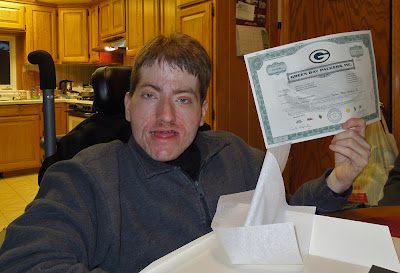Grasshopper Torte from Carl's Cake Shop: $18.00
Taking Mitch's posse out for a Birthday Lunch: $60.00
The look on his face when he realizes he's now a part-owner of the Green Bay Packers? Priceless
Saturday, March 3, 2012
Friday, February 24, 2012
Mitch will be 27 on the 27th of February!
Sign Here: Birthday Greetings Guest Book
Please keep checking back. More of Mitch's story and photos will be added in the coming days.
Sunday, February 19, 2012
Mitch's Birth | February 27, 1985
 |
| This was the first time I was able to hold Mitch. He was over 3 weeks old. Even at this young age, he was already a Wisconsin sports fan. |
Even though I had prenatal testing, we did not know anything was wrong until he was born. The delivery room was full of people, noise, and movement. I had been pushing for over an hour when finally he was delivered and suddenly, a hush fell over the room as though a switch was flipped. Mitch was born with a birth defect called spina bifida.
Spina bifida occurs within the first four weeks of pregnancy, before many women are aware that they are pregnant. For some unexplained reason, the embryo's neural tube (which develops into the brain, spinal cord, and vertebral column) fails to form properly, which results in varying degrees of permanent damage to the spinal column and the nervous system.
In the United States, approximately 1,500 infants are born with spina bifida each year.The level of involvement relates to the size and location of the defect along the spinal column. Seventy-five percent of children who are born with spina bifida will have a lumbar-sacral level defect, which are the lower areas of the spinal column. Twenty-five percent of children will have defects in the thoracic or the upper thoracic-cervical region. The defect may be limited to one vertebra, or, it may involve several vertebrae.
Mitch's lesion started at T2 (just below his neck) and ran to this sacrum (the lowest part of the spinal cord). We were told few infants born with lesions as high and as large as Mitch's rarely lived beyond the first few years of life. We were so lucky to have such a dedicated team of people caring for him.
Saturday, February 18, 2012
First Year
From behind the wall of an incubator, I saw Mitch for only a few
minutes before the special neonatal ambulance whisked him away to St
Mary's hospital in Madison. The next morning, when I finally got to St
Mary's, I saw him once before the neurosurgeon operated to close the
open lesion on his back. He was laid on a pillow on my lap. When the
nurse pulled back the sterile dressing to show me his back, I felt
faint. Seventy-five percent of his back was an open, oozing wound. The
edges of incomplete vertebra, a half-formed spinal cord, blood vessels,
muscle, tendon and ligaments were visible. What a shocking thing for a
twenty-two year old new Mom to see. I could not image how the surgeon
would ever find enough skin to close such a huge lesion. But his
extraordinary neurosurgeon, Dr. Woodford was able to do so during a 6
hour in surgery.
In the NICU (neonatal intensive care unit), despite the dire predictions, he seemed amazingly healthy. At 8 pounds, 4 ounces, he weighed more than his 3 room mates combined. Those poor preemies, with their immature nervous systems, startled, quaked, and cried much of the time. Mitch was like a little Buddha, his cheeks plumped from the butterfly IV in his scalp, his gaze calm and interested, his bed an island of serenity in a sea of irritable, unsettled babies.
Like many babies with spina bifida, Mitch developed hydrocephalus and had a shunt placed at 13 days to drain the excess fluid from his brain. Before a dad named John Holter invented the first working shunt, most babies with spina bifida and hydrocephalus died from untreated hydrocephalus. Read more about the Holter shunt and the amazing story behind it at these links:
When Mitch was 3 1/2 weeks hold, he was released from the hospital. He was home two days before we had to rush him back to the hospital to have his shunt replaced. It became clogged with protein. Between shunt replacements, ear tubes, a hernia repair, tendon surgery, and mysterious illness marked by a high daily fever, Mitch spent much for the first year of his life in the hospital. Many of the nurses became good friends.
In the NICU (neonatal intensive care unit), despite the dire predictions, he seemed amazingly healthy. At 8 pounds, 4 ounces, he weighed more than his 3 room mates combined. Those poor preemies, with their immature nervous systems, startled, quaked, and cried much of the time. Mitch was like a little Buddha, his cheeks plumped from the butterfly IV in his scalp, his gaze calm and interested, his bed an island of serenity in a sea of irritable, unsettled babies.
 | ||
| Cool wash cloths were used frequently to try to lower his fever which ran as high as 106F. |
- The Father's of Invention
- John Holter, brain engineer
- Reader's Digest - A Father's Last-Chance Invention.
 |
| This is a star car - Mitch used it for several years. It allowed him to play at floor level and move independently. |
Subscribe to:
Posts (Atom)




